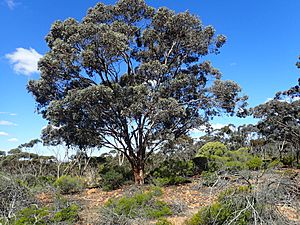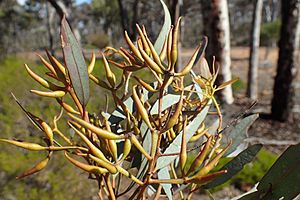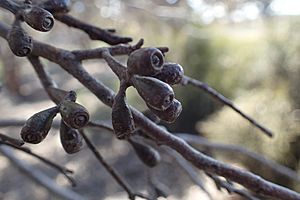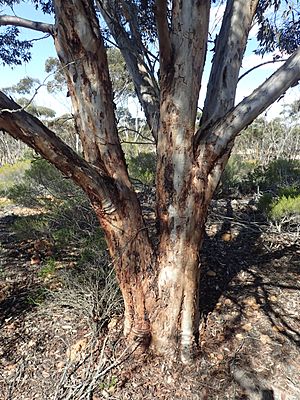Eucalyptus densa facts for kids
Quick facts for kids Eucalyptus densa |
|
|---|---|
 |
|
| Eucalyptus densa growing south of Tarin Rock | |
| Scientific classification | |
| Genus: |
Eucalyptus
|
| Species: |
densa
|
Eucalyptus densa is a special type of eucalypt tree or shrub. It is found only in Western Australia. This plant can grow as a "mallee" or a "mallet."
A mallee is a eucalypt that has many stems growing from the ground. A mallet is a eucalypt that has a single, short trunk. Eucalyptus densa has smooth, greyish bark that peels off in curly strips. Its leaves are long and narrow, and its flower buds look like spindles. The flowers are pale yellow or lemon-colored. After flowering, it produces woody, cone-shaped fruits.
Contents
What Eucalyptus densa Looks Like
Eucalyptus densa can grow to be about 1 to 12 meters (3 to 39 feet) tall. It has smooth bark that is pale grey to cream-colored. This bark peels off in curly flakes, which makes the tree look interesting.
Its adult leaves are a dull grey-green on both sides. They are long and narrow, like a spear, measuring about 4 to 9 centimeters (1.6 to 3.5 inches) long. Each leaf has a small stem called a petiole that connects it to the branch.
Flowers and Fruit
The flower buds of Eucalyptus densa grow in groups of seven or nine. They are found where the leaves meet the stem. Each group of buds sits on a stalk called a peduncle, which is about 1 to 2 centimeters (0.4 to 0.8 inches) long. Each individual bud also has a tiny stem called a pedicel.
When the buds are ready to open, they are long and spindle-shaped, about 1.7 to 3.5 centimeters (0.7 to 1.4 inches) long. They have a horn-shaped cap, called an operculum, which covers the flower inside.
Eucalyptus densa flowers can bloom at different times of the year, usually between January and February or from May to September. The flowers are a pretty pale yellow or lemon color. After the flowers, the plant produces woody fruits. These fruits are shaped like cones, cylinders, or barrels. They are called capsules and hold the seeds.
Naming and Types
Eucalyptus densa was first officially described in 1991. Two botanists, Ian Brooker and Stephen Hopper, gave it its scientific name. The name densa comes from a Latin word meaning "thick" or "compact." This refers to how dense or full the top part of the tree (its crown) can be.
There are two main types, or subspecies, of Eucalyptus densa:
- Eucalyptus densa subsp. densa: This type is a short-trunked mallet. It often has a very thick crown that can reach almost to the ground.
- Eucalyptus densa subsp. improcera: This type is a mallee that grows up to 3 meters (10 feet) tall. It has thinner stems compared to the other subspecies. The name improcera is Latin for "short" or "undersized," referring to its smaller size.
Where Eucalyptus densa Grows
This eucalypt species is found in the southern parts of the Wheatbelt and Goldfields-Esperance regions of Western Australia. It likes to grow on ridges, flat areas, and along drainage lines. You can find it in different types of soil, including clay, loam, sandy, or lateritic soils.
The subspecies densa is found in areas between Ongerup, Ravensthorpe, and Hyden. The subspecies improcera grows in the Ravensthorpe and Jerramungup areas.
Conservation Status
Both types of Eucalyptus densa are considered "not threatened" by the Western Australian Government's Department of Parks and Wildlife. This means they are not currently at risk of disappearing.




